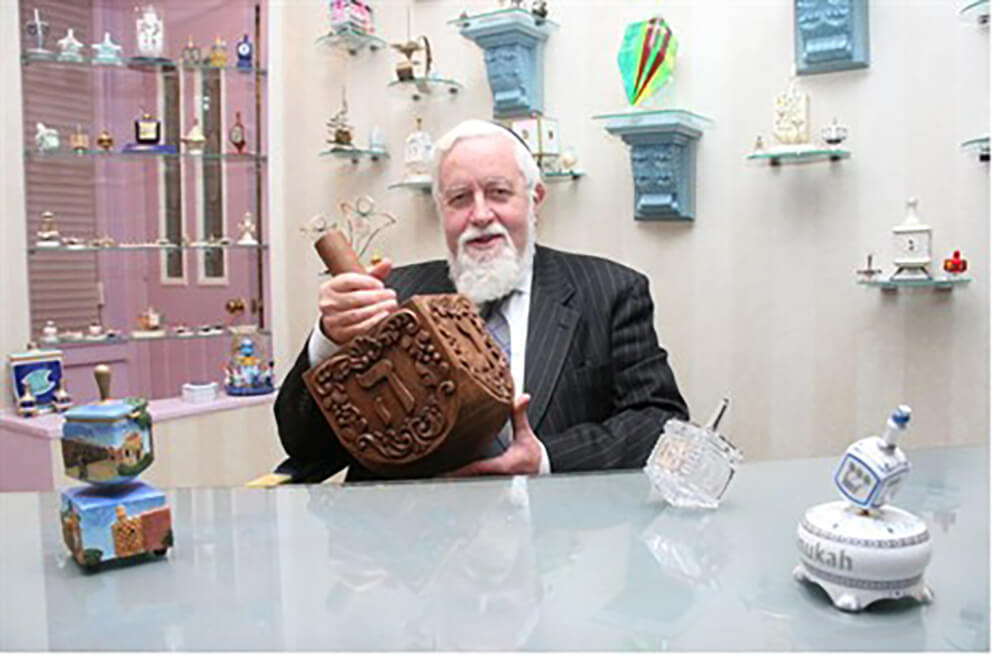By: Eliayhu Safran
Beis Yosef asked, “Why do we celebrate Chanukah for eight days if there was ample oil to last for one day? It would seem that the miracle was that the oil lasted an additional seven days… in which case, Chanukah should be celebrated for seven days, not eight.”
This most famous of Chanukah questions can certainly give one pause. Not that there are not any number of answers given. Indeed, there are hundreds of answers that have been offered over the ages to Beis Yosef’s question. Some are logical. Some are fanciful. All try to go to the heart of Chanukah and what it means to the Jewish people.
There is one answer that speaks to me. It offers a hint to why I am so enamored with my ever-growing dreidel collection; a collection that I began some twelve years ago when I met my beloved wife, Clary. I remember that moment so clearly. It was the second night of Chanukah… yes, it was a miracle for me to have met my dear Clary. But even that remembrance begets a Chanukah question. In my heart, the dreidle came to symbolize that wonderful meeting and yet… wouldn’t a single grandiose dreidle have been enough to commemorate that life-transforming moment? Why did I feel moved – some might suggest compelled – to continue to amass dreidle after dreidle, growing my collection into hundreds upon hundreds of dreidles from the United States, from Israel, from Spain, Hungary, India, Russia, Scotland… indeed, from all over the world. So many wondrous tops! So many that anyone who comes into the room where I keep my many volumes of books will find themselves transported by the sight of them.
No single dreidel for me, no! For me, hundreds of dreidels, made from a broad array of materials, coming in all sizes and colors. Some, when you spin them, perform with little music boxes. Dreidel, dreidel, dreidel, I made it out of clay…
But why more dreidels every year?
It is a rare visitor to our home who doesn’t view my wonderful collection and then, the smile fading from his or her face, “But, Rabbi Safran, of all the things in the world to collect, why dreidles?”
Ah, lest you think that my collection is simply whimsy, an opportunity to recall the delightful evenings of childhood when the joy of Chanukah filled my household, let me share with you my response. “What,” I ask, “does the dreidel teach us? What is its message?”
Nes Gadol Haya Poh (in Israel) or Nes Gadol Haya Sham (outside Israel)
A great miracle happened t/here!
Step into my library and you see hundreds upon hundreds of reminders that miracles surround us, here, there, and everywhere. No matter where we look, our lives are touched by miracle. Our lives are miracles.
Just as God is everywhere, so too are the miracles that He brings about. His miracles are as unceasing as His love. Each day, when we recite, Modim anachnu lach… we are reminded of God as the source of all daily miracles. Ve’al nisecha she’b’chol yom imanu (And for Your miracles (nissim) that are with us every day; and for Your wonders and favors (niflaos) in every season.”
The question then should not be, Why so many dreidels? The question should be, Why not more and more and more? We can never have enough dreidels. We can never exhaust our praise for God’s wonders and miracles.
Wonders (niflos) surround us everywhere. They are, at once, special and ordinary. So ordinary that we often take them for granted. The rain, the blossoming flower, the brilliance of a blue sky, even the very air we breathe. All these wonders… and we experience them without giving them a second thought! We call them teva, nature. And we experience them the way we do because they represent the wonderful world the way it is supposed to be.
Miracles, on the other hand, are… well, miraculous. We recognize miracles as being “out of the ordinary.” It is, as has been noted, a break from the natural routine. They are those events that are, quite literally, “nothing short of miraculous.”
Which brings us back to Chanukah. During the time of the Second Temple, a small, valiant band of Jews fought the mighty Greek armies. They miraculously defeated them and won back not only the Temple but their religious freedom.
On the 25th day of Kislev, we once again lit the chanukiah in the Temple, only to realize that all but one flask of oil had been defiled. Only one. Enough for one night of light. But then another miracle occurred and the oil burned for eight days.
Our Sages teach that there is no real difference between nature and miracles; God’s hand guides everything in the world. However, we are often so lost in our routine that we become blind to the wonder of God’s hand all around us. “Nature” is just the word we use to speak of the breathtaking beauty and symmetry of God’s Creation becoming routine.
We expect it.
A miracle, though, shakes us from our stupors. A miracle breaks our routine and draws our attention to God’s dominion over all life.
Dreidels, delightful, silly, wonderful, playful little dreidels, remind us of the existence of miracles.
(INN)
Rabbi Dr. Eliyahu Safran is the Vice President of Communications and Marketing at the Orthodox Union (OU) Kashrut Division





